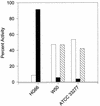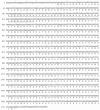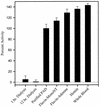Purification, characterization, and sequence analysis of a potential virulence factor from Porphyromonas gingivalis, peptidylarginine deiminase
- PMID: 10377098
- PMCID: PMC116503
- DOI: 10.1128/IAI.67.7.3248-3256.1999
Purification, characterization, and sequence analysis of a potential virulence factor from Porphyromonas gingivalis, peptidylarginine deiminase
Abstract
The initiation and progression of adult-onset periodontitis has been associated with infection of the gingival sulcus by Porphyromonas gingivalis. This organism utilizes a multitude of virulence factors to evade host defenses as it establishes itself as one of the predominant pathogens in periodontal pockets. A feature common to many other oral pathogens is the production of ammonia due to its protective effect during acidic cleansing cycles in the mouth. Additionally, ammonia production by P. gingivalis has been proposed as a virulence factor due to its negative effects on neutrophil function. In this study, we describe the first purification of a peptidylarginine deiminase (PAD) from a prokaryote. PAD exhibits biochemical characteristics and properties that suggest that it may be a virulence agent. PAD deiminates the guanidino group of carboxyl-terminal arginine residues on a variety of peptides, including the vasoregulatory peptide-hormone bradykinin, to yield ammonia and a citrulline residue. The soluble protein has an apparent mass of 46 kDa, while the DNA sequence predicts a full-length protein of 61.7 kDa. PAD is optimally active at 55 degrees C, stable at low pH, and shows the greatest activity above pH 9.0. Interestingly, in the presence of stabilizing factors, PAD is resistant to limited proteolysis and retains significant activity after short-term boiling. We propose that PAD, acting in concert with arginine-specific proteinases from P. gingivalis, promotes the growth of the pathogen in the periodontal pocket, initially by enhancing its survivability and then by assisting the organism in its circumvention of host humoral defenses.
Figures








References
-
- Altschul S F, Gish W, Miller W, Myers E W, Lipman D J. Basic local alignment search tool. J Mol Biol. 1990;215:403–410. - PubMed
-
- Bjellqvist B, Hughes G J, Pasquali C, Paquet N, Ravier F, Sanchez J C, Frutiger S, Hochstrasser D. The focusing positions of polypeptides in immobilized pH gradients can be predicted from their amino acid sequences. Electrophoresis. 1993;14:1023–1031. - PubMed
-
- Boyde T R, Rahmatullah M. Optimization of conditions for the colorimetric determination of citrulline, using diacetyl monoxime. Anal Biochem. 1980;107:424–431. - PubMed
-
- Carlsson J, Hofling J F, Sundqvist G K. Degradation of albumin, haemopexin, haptoglobin and transferrin, by black-pigmented Bacteroides species. J Med Microbiol. 1984;18:39–46. - PubMed
MeSH terms
Substances
LinkOut - more resources
Full Text Sources
Other Literature Sources
Molecular Biology Databases

